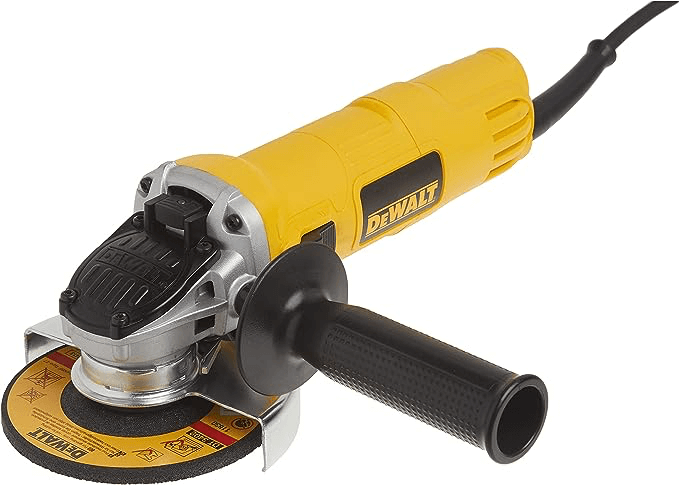
An angle grinder has different names attached to it. Sometimes, it is also known as a side grinder or disc grinder. An angle grinder is a powerful handheld tool, and its important feature is a rotating disc.
With the help of the rotating disc, the cutting, grinding, and polishing of various materials, metals, concrete, and wood can be done. It is a multipurpose tool, and it is essential in every home.
Now, the question is if it is okay to use it on wood. Absolutely, yes! When you are handling wood to make something out of it, you may want to polish it or trim the edges and give it a more refined look.
Ways to Use Angle Grinder on Wood
Using an angle grinder on wood can be a bit different than using it on metal. Here are some general steps to help you know how to use an angle grinder.
- Clear the area of any debris or flammable materials because you do not want your workspace to catch fire and vanish in flames. Consider setting up a workbench or clamping the wood securely.
- For wood, you’ll want to use a carving or shaping disc, which typically has multiple teeth or cutters. These attachments are specifically designed for woodwork. Remember, only the right tool can give you the desired shape or results.
- Put on your safety gear, including goggles, a dust mask, and gloves. Protecting yourself is essential because many unfortunate incidents can happen in workspaces.
- Begin by testing the angle grinder on a scrap piece of wood to get used to the tool’s feel and speed. This way, you will know if the tool is working fine or not. Familiarize yourself with its power.
- Unlike with metal, wood requires less force. Let the grinder’s speed and the attachment’s sharpness do most of the work. Move the grinder in smooth, controlled motions.
- Use the angle grinder to shape, smooth, or carve the wood according to your desired design. Take your time and be mindful of the grinder’s movement because it moves at great speed, and you may injure yourself.
What You Can Do with An Angle Grinder
An angle grinder is a versatile tool that can be used for various tasks. Here are a few things you can make or do with an angle grinder:
1. Metal Cutting
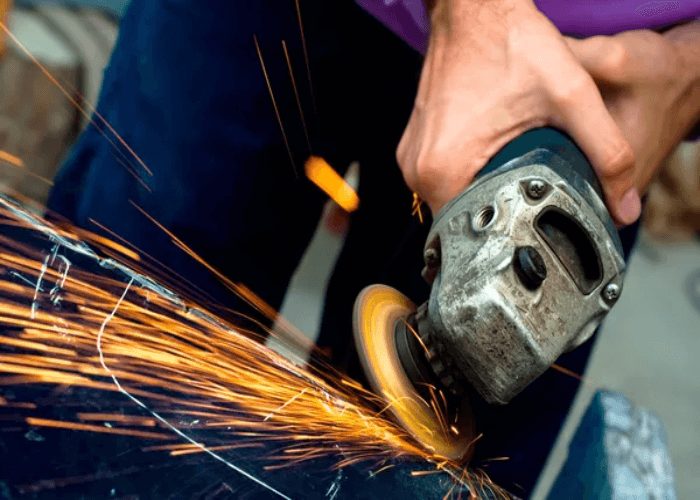
Angle grinders are commonly used for cutting metal, such as steel or aluminum. They can be used to cut through pipes, rods, or sheets of metal.
2. Grinding and Shaping

This tool can also be used to grind and shape metal or other materials. It can help smooth rough edges or remove excess material.
3. Removing Rust or Paint
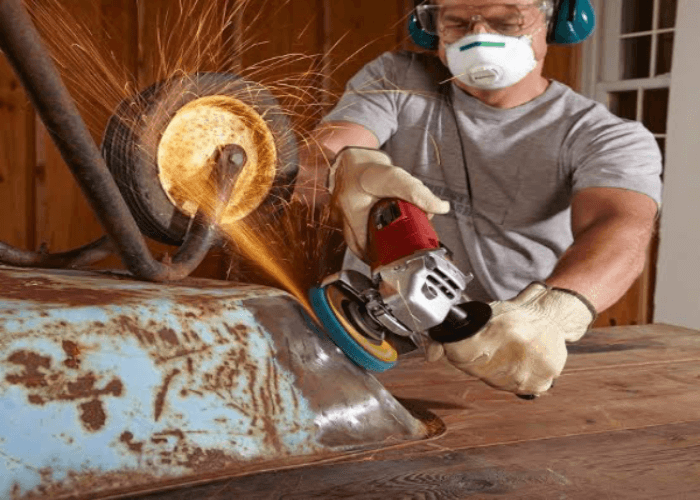
An angle grinder with a wire brush attachment can efficiently remove rust or old paint from metal surfaces.
4. Cutting Tiles or Masonry
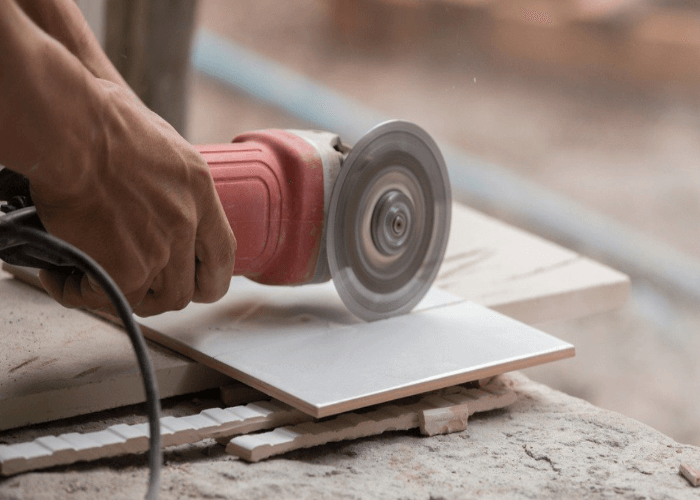
With the appropriate cutting disc, an angle grinder can be used to cut tiles or masonry, such as bricks or concrete.
5. Sharpening Tools

Some angle grinders can be used for sharpening tools like lawn mower blades, axes, or chisels.
6. Polishing or Buffing
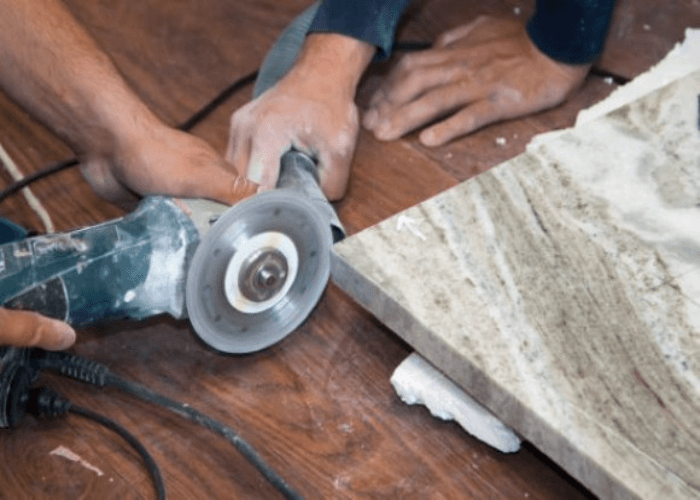
By using a polishing or buffing attachment, an angle grinder can be used to give a shiny finish to metal surfaces.
Precautions While Using Angle Grinders on Wood
While angle grinders are versatile tools, they can also pose certain risks if not used correctly or with proper safety precautions. Some accidents that angle grinders can cause include the following.
- Kickback: If the disc of the angle grinder gets caught or pinched in the material being cut or ground, it can cause a kickback. This sudden, violent reaction can result in loss of control of the tool and potential injury.
- Flying debris: When using an angle grinder, sparks, metal fragments, or other debris may be ejected from the workpiece. These can cause eye or face injuries if not protected by safety glasses or a face shield.
- Disc breakage: If the disc used on the angle grinder is damaged, worn out, or inappropriate for the task, it can shatter during operation. This can result in sharp fragments flying in various directions, causing serious injury.
- Electrical hazards: Angle grinders use electricity, so improper use of power sources, damaged cords, or exposure to water or other liquids can result in electrical shock or even electrocution.
- Burns and cuts: The discs of an angle grinder can become very hot during use. Touching or coming into contact with the heated surface can cause severe burns. Additionally, the rotating disc can pose a cutting hazard if it comes into contact with the user’s body parts or clothing.
To prevent accidents while using an angle grinder, it is essential to follow safety guidelines, such as wearing proper protective gear (goggles, gloves, dust mask), inspecting the discs before use, securing the workpiece, and maintaining a firm grip on the tool. Always familiarize yourself with the specific safety instructions the manufacturer provides and use the appropriate guards and safety features.
Conclusion
An angle grinder may have been initially designed for harder objects like metals, rocks, etc., but it can also work fine with wood.
Construction works, carpentry, and DIY projects have been made easier and smoother with the help of angle grinders.
Work that could take hours and hours has been reduced to a few minutes because of this time-saving tool.
Today, angle grinders are loved and commonly utilized because of their versatility and their ability to perform a wide range of tasks.
For a person who is regularly engaged in DIYs or professional work, it is essential to keep a good angle grinder with you always.
Gray Williams
Related posts
Stay connected
Today's pick
- Things to Remember While Designing Your Custom Modular Kitchen in GurgaonGurgaon now known as Gurugram is the second largest city in the state of Haryana and is a reflectiossn of an ideal modern city with futuristic goals. Witnessing rapid urbanization, it has also emerged as a hub for contemporary homes, with homeowners seeking innovative and... The post Things to Remember While Designing Your Custom Modular […]

